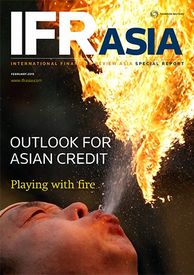Keeping the pace
The threat of US rate hikes hangs over the credit markets in 2015, but strong growth prospects and bank capital constraints mean Asia’s bond markets are in for another busy year.

Playing with fire Source: REUTERS A stuntman spits fire during a performance at a tourist attraction in Kaifeng, Henan province. Asian credit has been enjoying its time in the sun in recent years. Companies across the region have been able to fund their growth plans at low rates, and investors have done well. Nevertheless, the start of 2015 has served up a reminder that Asian bonds can be a decidedly risky business. Kaisa Group, the first Chinese property company to miss a coupon payment on a US dollar bond, has sounded the alarm bells. The...Read more
To purchase printed copies or a PDF of this report, please email leonie.welss@lseg.com and shahid.hamid@lseg.com
The threat of US rate hikes hangs over the credit markets in 2015, but strong growth prospects and bank capital constraints mean Asia’s bond markets are in for another busy year.
Asia’s G3 bond markets face some serious challenges in 2015, but bankers remain optimistic that the region’s primary debt markets can continue to grow
Asia’s lenders are largely well capitalised, but, to keep pace with economic growth, they need to keep raising Tier 1 and Tier 2 capital, at least half which is likely to come from local markets.
The biggest long-term capital funding consideration for Asian banks could be whether or not the concept of total loss-absorption capacity (TLAC) gains traction. The Financial Stability Board, an international advisory body, outlined the concept of TLAC in a consultative document on November 10. The idea is that global systemically important banks (G-SIBs) earmark a set of instruments over and above their Tier 1 and Tier 2 capital for loss absorption in the event of financial disarray without having to turn to depositors or seek a government...
China’s domestic capital market holds the key to the overhaul of the country’s sprawling web of local government finances, and efforts to introduce municipal bonds are beginning to bear fruit.
Early signs since Narendra Modi’s election victory hint at India’s enormous potential in the global capital markets, but can issuers take advantage of international investors’ new-found confidence?
The Singapore dollar bond market has made a cautious start to 2015 after last year’s oil price slump left many investors nursing heavy paper losses on energy-related names.
Asian demand for Australian dollar assets has lifted the issuance of Kangaroo bonds to a post-crisis peak and helped deepen Australia’s debt markets.
Investors expect Asian bonds to overcome concerns over Chinese high-yield credits, paving the way for more first-time issuers to access the international markets.